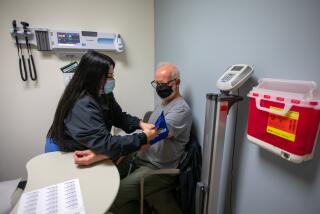Let patients weigh in on treatment decisions
- Share via
Mr. L. greeted me with a strong handshake. He seemed like a very fit fellow, particularly for a 90-year-old. His nephew and nephew’s wife accompanied him to the consultation.
As he spoke, unknowingly, Mr. L. was telling me the diagnosis. He reported several months of unrelenting hoarseness. Not good news. The examination revealed what I suspected: a tumor of both vocal cords, most likely cancer.
I could detect no enlarged lymph nodes or other signs that it had spread beyond the voice box; that much was good news.
I told the patient and family there was a tumor involving both vocal cords, that it was the cause of the hoarseness and that it may be malignant. A biopsy and examination by a highly specialized pathologist would give us a certain answer. That biopsy report was unsurprising: malignancy of both vocal cords that was happily not aggressive. Scans showed no tumor beyond the voice box.
Standard treatment options were radiation or removal of the voice box. Both treatments had a high cure rate. However, each would incapacitate him. Radiation causes dry mouth and throat with difficulty swallowing, while voice-box removal would have left him without speech -- a fearful prospect. Although “esophageal speech,” a technique that uses belching to force sound out of the mouth, can be taught and mastered, the technique is taxing and demanding at any age, let alone age 90.
Because of the importance of the treatment decision, and to reassure the patient, I recommended consultation at the medical school where I taught. There, the Tumor Board -- a panel of senior specialists -- gave a consensus opinion that the two treatment alternatives were standard and reasonable. Immediately after the consultation, I met with the patient, his nephew and the nephew’s wife and relayed the board’s consensus.
There was a period of silence. Then Mr. L.’s nephew, an engineer, posed a question: “Since both treatments are rather radical and likely to create some disability, and since my uncle at 90 has a limited number of years, what if you just nibbled away at it every so often? And just see what happens.”
I pondered that unanticipated question, then replied, “You know, not a bad idea. Not standard textbook treatment but . . .”
I asked Mr. L. and the family to let me think about it for one day and consider the logistics. A quick bit of internal deliberation told me this plan made medical sense. Since the tumor could be viewed by looking into the throat with a small mirror, we could, on a regular basis, as needed, nip away at the visible tumor. His voice, although slightly imperfect, would be spared, plus there would be no chance of suffocation by an unchecked cancer. It would be a holding pattern, not a cure -- a practical solution for some uncertain period of time, particularly because this tumor had little potential to spread. Also uncertain was how long the 90-year-old gentleman would live.
I liked the premise of the nephew’s suggestion; we would strike a compromise with nature. Engineers are logical thinkers and practical problem-solvers.
The first tumor-shaving session went well. Months later, we repeated it. Later, we did it again. Each time the patient did well and was able to go home after the treatment session with no down time, no pain and no change in his lifestyle. Mr. L. likened it to “going in for a haircut.” And each time, we could confirm no spread of the cancer.
This systematic, albeit unorthodox, cancer control went on for a couple of years. Then one day, I received a call from the nephew: Mr. L. had passed away peacefully from long-standing heart problems. The nephew expressed his appreciation for the care his uncle received, and he thanked me for accepting and executing a treatment plan devised by a layman.
I have often pondered that episode, which happened early in my career. Perhaps we physicians need more often to venture beyond rigid treatment “rules” and protocols. After presenting standard medical treatment options, we should ask: What does the patient want? What will the patient accept or tolerate? As long as we provide enough meaningful information delivered in comprehensible language to allow an informed decision, then we may arrive at a meaningful treatment that will satisfy the patient and his family and yet offer help and comfort.
We cannot forget that since no one can live forever, the quality of remaining life may trump the quantity.
All young physicians are taught the following aphorism: “Listen to the patient carefully, for he is giving you the diagnosis.” Perhaps we also should listen to the patient carefully because he can help us devise the treatment -- a joint venture of sorts. After all, we doctors are not gods. We must remember that the patient is the sole owner of his body and the life dwelling within it.
Dr. Robert Kotler is a facial cosmetic surgeon practicing in Beverly Hills. He teaches at UCLA and is the author of the 2003 book, “Secrets of a Beverly Hills Cosmetic Surgeon.”






